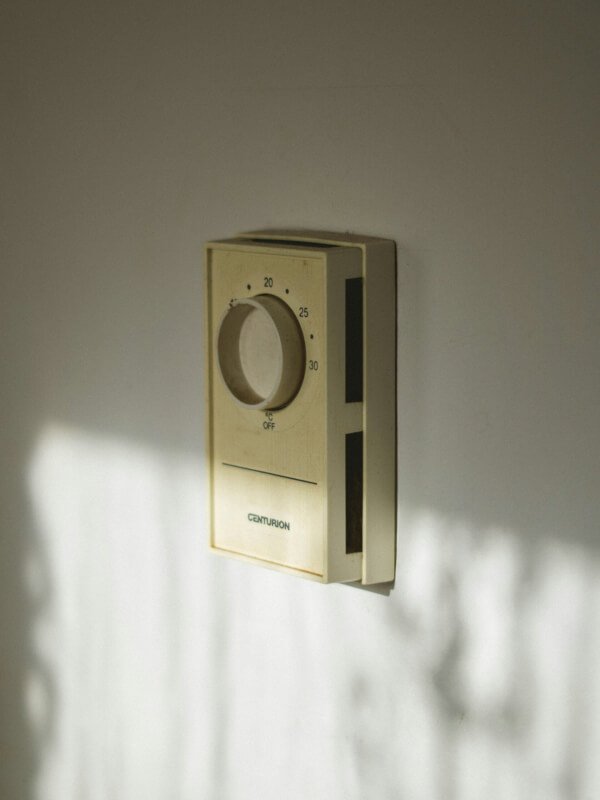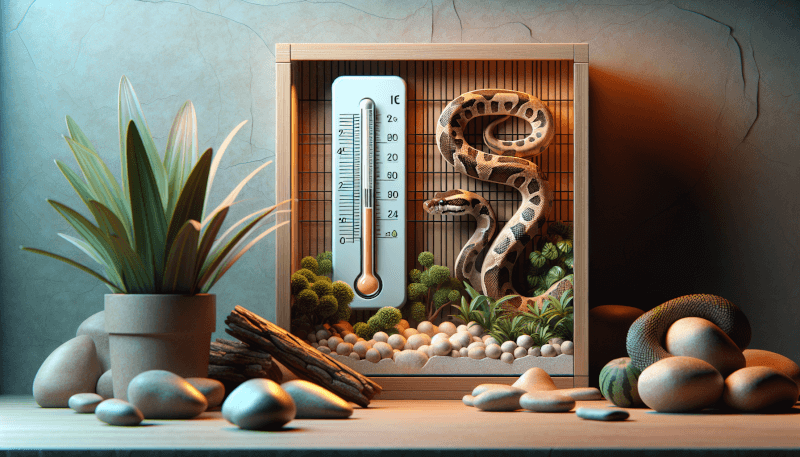Are you a snake owner or enthusiast looking for the best ways to ensure your snake’s habitat has the perfect temperature? Look no further! In this article, we will explore the most effective methods to monitor and control the temperature in a snake habitat. Maintaining the right temperature is crucial for the health and well-being of your snake, and with our helpful tips and tricks, you’ll be able to create a comfortable and safe environment for your scaly friend. So let’s get started and discover the best ways to provide optimal temperature conditions for your snake!

1. Types of Snake Habitats
Snakes can be found in various types of habitats, both natural and artificial. Understanding these habitats is crucial for providing the best care for your snake.
1.1. Natural Habitats
In the wild, snakes inhabit a diverse range of environments. Some snakes prefer arid deserts, while others thrive in dense tropical rainforests. Natural habitats offer a variety of temperature zones, from hot to cool areas, allowing snakes to regulate their body temperature effectively.
1.2. Artificial Habitats
When snakes are kept as pets, they require a suitable artificial habitat. This allows snake owners to recreate the necessary temperature zones and environmental conditions to mimic their natural habitats. Artificial habitats can be in the form of enclosures or terrariums equipped with heating and cooling systems.
2. Importance of Maintaining Proper Temperature
Maintaining the proper temperature is essential for the health and well-being of your snake. Snakes are ectothermic creatures, meaning they rely on their surroundings to regulate their body temperature.
2.1. Thermoregulation in Snakes
Thermoregulation is the process by which snakes regulate their body temperature. Snakes move between different temperature zones within their habitat to reach their preferred body temperature. This allows them to carry out vital physiological functions such as digestion, immune system function, and reproduction.
2.2. Risks of Inadequate Temperature Control
Inadequate temperature control can have serious consequences for snakes. If the temperature is too low, the snake’s metabolism can slow down, leading to digestive issues and a weakened immune system. On the other hand, if the temperature is too high, the snake may become stressed, dehydrated, or even suffer from heat stroke. Therefore, monitoring and maintaining proper temperatures are crucial to their overall health and well-being.

3. Monitoring Tools
To ensure that the temperature in your snake’s habitat remains within the optimal range, monitoring tools are essential.
3.1. Thermometers
Thermometers are the most basic and important tool for monitoring the temperature in a snake’s habitat. There are various types of thermometers available, including digital thermometers and analog thermometers. It is important to choose a reliable thermometer that provides accurate readings.
3.2. Hygrometers
In addition to temperature monitoring, hygrometers measure humidity levels in the snake’s habitat. Maintaining proper humidity levels is crucial, especially for snake species that require specific humidity ranges. Hygrometers help snake owners ensure that the humidity within the enclosure remains within the appropriate range.
4. Heating Options
Providing appropriate heating options in a snake’s habitat is crucial for mimicking their natural thermal environment.
4.1. Heat Pads
Heat pads, also known as under-tank heaters, are a popular choice for providing heat to the bottom of the snake’s enclosure. These pads adhere to the bottom surface of the enclosure and emit a steady heat. Heat pads allow snakes to thermoregulate by providing a warm surface for them to rest on.
4.2. Heat Lamps
Heat lamps are another common heating option for snake habitats. These lamps emit heat and light, replicating the sun’s warmth. Heat lamps are especially beneficial for snake species that require higher temperatures and basking areas. It is important to choose the appropriate wattage and ensure that the heat lamp is securely attached to prevent accidents.
4.3. Ceramic Heaters
Ceramic heaters are a safe and efficient heating option for snake habitats. These heaters emit heat without any light, making them ideal for reptiles that require darkness or have sensitivity to light. Ceramic heaters can be installed within the enclosure or mounted externally to provide heat.

5. Cooling Options
Snakes also require cooling options within their habitat to avoid overheating.
5.1. Air Conditioning
Air conditioning can be used to regulate the temperature and maintain a cool side within the snake’s habitat. This is especially important during hot summer months or in regions with high temperatures. Air conditioning helps prevent the habitat from becoming excessively hot, ensuring the snake remains comfortable and healthy.
5.2. Fans
Fans are a cost-effective and simple way to promote air circulation and provide cooling within the snake’s enclosure. Fans help dissipate heat and maintain a suitable ambient temperature. It is important to ensure that fans are properly installed and positioned to avoid creating strong air currents that may stress the snake.
6. Temperature Zones in a Snake Habitat
Creating distinct temperature zones in a snake’s habitat is essential to meet their thermoregulation needs.
6.1. Hot Side
The hot side of the enclosure should provide a temperature range that allows the snake to increase its body temperature. This is typically achieved by placing a heating source, such as a heat pad or heat lamp, in this area. The hot side temperature should be in the range preferred by the specific snake species.
6.2. Warm Side
The warm side of the enclosure is where the snake can maintain its body temperature once it has warmed up on the hot side. This area should have a slightly lower temperature compared to the hot side, providing a comfortable resting spot for the snake.
6.3. Cool Side
The cool side of the enclosure should offer a lower temperature compared to the warm side. This allows the snake to regulate its body temperature and cool down when needed. The cool side should be free from any direct heating sources.

7. Proper Placement of Heating and Cooling Sources
The strategic placement of heating and cooling sources within the snake’s habitat is crucial for creating the ideal temperature gradient.
7.1. Hot Side Placement
When placing heating sources, such as heat pads or heat lamps, it is important to position them on one side of the enclosure to create the desired temperature gradient. This ensures that the snake can freely move between the hot and cool sides to regulate its body temperature effectively.
7.2. Cool Side Placement
The cool side of the enclosure should be away from any direct heating sources to provide a temperature drop and a comfortable cooling area for the snake. Placing it opposite the hot side allows for the creation of an ideal temperature gradient within the enclosure.
8. Insulation and Temperature Retention
Proper insulation is essential for maintaining a stable temperature environment within the snake’s habitat.
8.1. Proper Enclosure Design
Choosing the appropriate enclosure design can help with temperature retention. Enclosures with insulated walls and lids help prevent the escape of heat or cool air, ensuring a more stable temperature for the snake. It is important to use materials that provide sufficient insulation without posing any health risks for the snake.
8.2. Insulating Materials
Using insulating materials, such as foam panels or reflective materials, can further enhance the insulation properties of the enclosure. These materials help reduce heat loss or gain and maintain a consistent temperature within the habitat. Care should be taken to ensure that these materials are snake-safe and do not contain any toxic substances.

9. Considerations for Specific Snake Species
Different snake species have varying temperature requirements based on their natural habitats.
9.1. Desert Snakes
Desert snakes, such as the ball python or corn snake, require warmer temperatures during the day and cooler temperatures during the night. They also require a low humidity environment. It is crucial to replicate these conditions in their habitat to promote their overall well-being.
9.2. Tropical Snakes
Tropical snakes, such as the boa constrictor or green tree python, thrive in higher temperatures with elevated humidity levels. Their habitats should be designed to provide a warm and humid environment, resembling their natural tropical habitat.
9.3. Arboreal Snakes
Arboreal snakes, such as the emerald tree boa or Amazon tree boa, require vertical spaces with temperature gradients. Providing climbing branches and elevated basking areas is essential for these snakes to regulate their body temperature effectively.
10. Regular Temperature Monitoring and Adjustment
Regular temperature monitoring and adjustment are necessary to ensure the snake’s habitat maintains the appropriate temperature ranges.
10.1. Frequency of Monitoring
Temperature monitoring should be conducted at least once a day to ensure the temperatures remain within the desired ranges. This allows for any necessary adjustments to be made promptly. It is also important to monitor temperature fluctuations during different times of the day or as seasons change.
10.2. Adjusting Temperature
If the temperature within the snake’s habitat deviates from the optimal range, adjustments should be made accordingly. This may involve adjusting the heating or cooling sources, insulation materials, or location of temperature-sensitive items within the enclosure. Regular monitoring and adjustment are crucial for providing the best possible care for your snake.
In conclusion, ensuring a proper temperature environment for your snake is essential for its health and well-being. By understanding the types of snake habitats, the importance of temperature regulation, and the various tools and options available for monitoring and controlling temperature, snake owners can create a comfortable and suitable environment that mimics their natural habitat. Regular monitoring, adjustments, and consideration of species-specific temperature requirements are essential to provide the best possible care for your snake.


